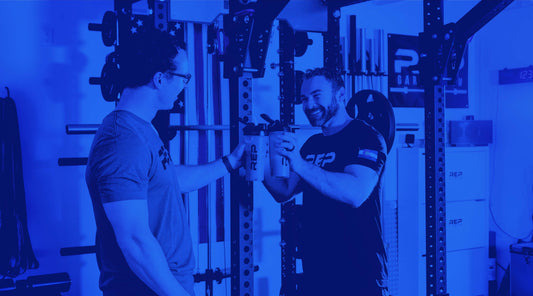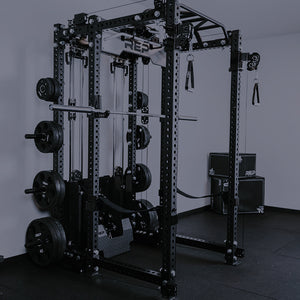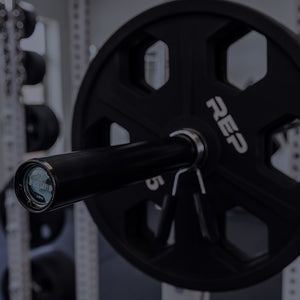
If you're hoping to strengthen your posterior chain (or add some junk to your trunk), there's one exercise you absolutely should not sleep on: the barbell hip thrust (BHT). This accessible move requires equipment you probably already have on hand, and is chock-full of benefits across a wide range of muscle groups.
Of course, as with any strength training movement, using proper technique is key. I spoke with trainer Monica Henrichs, CSCS, to learn the correct execution for this glute-tastic exercise, so whether you're working on your hip thrusts at home or in the gym, you'll nail rep after rep.
Hip thrust benefits
Before we get into the "how," let's cover the "why."
The list of muscles a barbell hip thrust works is long—and that's why we love it. "Barbell hip thrusts work your glutes, hamstrings, lower back, core, and quads," Henrichs explains. Talk about a power move!
All of those muscle groups come into play with other heavy lifting movements like deadlifts or squats, so incorporating hip thrusts into your workouts can help support your more traditional lifting goals.
Plus, while there are other strength training moves that offer similar glute- and quad-building benefits (lookin' at you, back squat), the barbell hip thrust requires significant hip extension. Studies show that hip thrusts in particular are more effective at activating hip extensors than more conventional exercises, which makes the BHT a great pick for anyone who spends most of their day sitting (so... most of us).
How to do a barbell hip thrust
Ready to perfect your barbell hip thrust form? Follow these three easy steps to get started.
Step 1: Set up for success
First, lean your shoulders against a bench or box and hold a barbell (with the weight of your choosing) in your hip crease.
Pro tip: "Maintain good alignment during initial setup," says Henrichs. "Keep the base of your shoulder blades on the corner of the box or bench, the barbell centered on your hips, your knees above your ankles, and toes tracking forward or slightly turned out."
Step 2: Lengthen and lift
Next, press into your feet to press your back into the bench behind you, raising your hips. Engage through your core and squeeze your glutes to extend your hips at the top, so your body is in a straight line from your head to your knees (knees should be bent at 90 degrees).
Pro tip: "Aim to find a range of motion that lengthens your glutes," Henrichs advises. "Shifting weight slightly into the heels (not lifting toes), can be beneficial in loading the glutes to the maximum length in range of motion at the bottom of the move. Then at the top, avoid overextending up into the bar. Stop in a neutral (think: plank hold) position.
Step 3. Rep it out!
Once you've thrusted your hips to the top of the movement and returned to the bottom, you've completed one rep. Consider working fewer reps with heavier weight to increase muscle mass, or ramp up the reps with lighter weight to build endurance.
How not to do a barbell hip thrust
As with every exercise, there are a few common mistakes Henrichs sees on the reg. "One common mistake is over-extension at the top, where the glutes are no longer the primary mover, but the erector spinae (lower back) muscles take over, potentially causing overuse or injury in these muscles," says Henrichs.
Placement of feet and alignment of joints during the movement is also a common mistake. "Feet should be placed as close to directly under the knees as possible," she says. "When the movement is performed, your knees should stay in line with your hips, not caving in (think: parallel femurs)."
And, lastly, Henrichs says folks often miss out on the benefits of hip thrusts when they limit their range of motion. "Not going deep enough to lengthen the glutes limits full effectiveness," she adds.
What equipment do you need for a barbell hip thrust?
Whether you have a gym membership or a home gym, you likely have everything you need to perform a BHT. This move requires:
- A bar:This might be obvious, but to do a barbell hip thrust you'll need... a barbell. Luckily, REP has no shortage of options to choose from.
- A pad (optional): Resting a barbell in your hip creases can be a little uncomfortable, especially as you load on more weight. If that's true for you, consider adding a barbell shoulder pad to your arsenal.
- Plates: When it comes to weight, you can slide whatever you like onto your bar (provided you can thrust it!). However, bumper plates make for a less noisy and clanky workout.
- A bench or box: To get your body into the proper position, you'll need to prop your shoulders against a weight bench or a box. Whichever you choose, make sure it's sturdy (like the REP Nitehawk Bench) so it doesn't slide around while you thrust.
Barbell hip thrust alternatives
Bodyweight hip thrusts
If you want to practice your barbell hip thrust form, try working through the exercise without a barbell. You'll still get a great hip extensor stretch and, provided you squeeze your glutes and core at the top of the movement, a handful of reps will ensure you feel the burn.
Pro tip: Performing a glute bridge on the floor is another way to get a similar lengthen-and-strengthen effect without added weight or the elevation from a bench.
Single leg hip thrusts
Want to take the BHT up a notch? Try a single leg hip thrust. It puts more load on one side of your body, which not only helps build strength, but challenges your stability.
To perform a single leg hip thrust, find the top position of a traditional BHT (upper back pressed into a mat, hips extended, knees bent at 90 degrees, directly over your feet). Holding the weight in your hip crease, extend one leg off the floor and hold it as you dip your hips to the bottom position. Press into your grounded foot to extend back to the top position, keeping your hips square as you go.
Dumbbell hip thrusts
If you don't have a barbell handy or just would rather perform a hip thrust with lighter weight, try a dumbbell hip thrust. The setup and execution is exactly the same as a BHT, but with a pair of dumbbells (or a single DB) held in your hip crease.
Smith machine hip thrusts
You can also perform a BHT on a Smith machine, which is especially helpful for anyone trying to up their weight. Smith machines lock into place at multiple heights, which makes them extremely safe as you kick up the KGs. Check out our guide to Smith machine hip thrusts to learn more.
Takeaway
In short, we love the barbell hip thrust. This lower body move can help build glute, hamstring, quad, and core strength, and it can be easily modified for lifters of all levels. When executed correctly, the BHT encourages healthy extension throughout your hips, which is particularly helpful for desk workers.
Grab a barbell, and get to thrustin'.
SOURCES:
Neto, Walter Krause et al. “Barbell Hip Thrust, Muscular Activation and Performance: A Systematic Review.” Journal of sports science & medicine vol. 18,2 198-206. 1 Jun. 2019

NEWSLETTER SIGNUP
Product launch information, promotions, blogs, and REP news.







